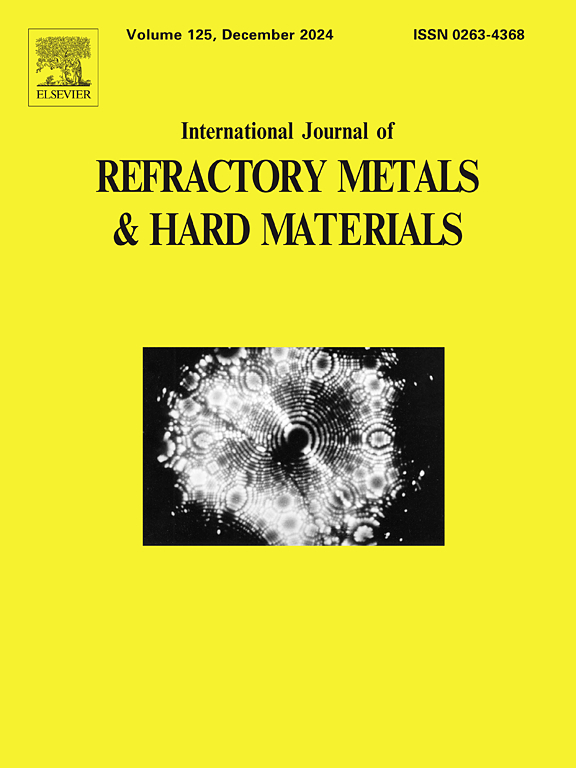Study on the interfacial behavior of tungsten alloy/steel diffusion bonding using Nb/Ni composite interlayer
IF 4.2
2区 材料科学
Q2 MATERIALS SCIENCE, MULTIDISCIPLINARY
International Journal of Refractory Metals & Hard Materials
Pub Date : 2025-05-15
DOI:10.1016/j.ijrmhm.2025.107237
引用次数: 0
Abstract
The interfacial microstructure and fracture behavior of tungsten alloy/steel joints bonded using an Nb/Ni composite interlayer were systematically investigated. Microstructural characterization and mechanical property evaluations confirmed the successful bonding of the joints. The Nb/Ni interface predominantly consisted of NbNi, NbNi3 and Nb4C3-x intermetallic compounds (IMCs), while the tungsten alloy/Nb interface featured Nb(Ni,Fe) IMCs. Transmission electron microscopy analyses (TEM) and electron probe micro analyses (EPMA) revealed that Nb4C3-x forms through the Ni substrate, exhibiting a needle-like morphology penetrating into the NbNi3 phase at the Nb/Ni interface. The supplementary experiments further confirmed that the formation of Nb4C3-x IMCs results from carbon diffusion originating in the steel substrate. A maximum tensile strength of 384 MPa was achieved at a bonding temperature of 1000 °C, with fractures displaying a combination of tungsten particle cleavage and ductile tearing within Nb and γ(Ni,Fe), reflecting enhanced interfacial bonding and mechanical performance. There are many holes on the fracture at low bonding temperature due to insufficient diffusion, while the fracture at high bonding temperatures contains numerous intact tungsten particles, primarily resulting from the formation of brittle Nb(Ni,Fe) IMCs.
Nb/Ni复合中间层钨合金/钢扩散结合界面行为研究
系统地研究了Nb/Ni复合夹层连接钨合金/钢接头的界面组织和断裂行为。显微组织表征和力学性能评估证实了接头的成功结合。Nb/Ni界面主要由NbNi、NbNi3和Nb4C3-x金属间化合物(IMCs)组成,而钨合金/Nb界面主要由Nb(Ni,Fe)金属间化合物组成。透射电镜分析(TEM)和电子探针微观分析(EPMA)表明,Nb4C3-x在Ni衬底形成,在Nb/Ni界面处呈针状穿透NbNi3相。补充实验进一步证实了Nb4C3-x IMCs的形成是源于钢基体中的碳扩散。当结合温度为1000℃时,合金的最大抗拉强度达到384 MPa,断口呈现出钨颗粒解理和Nb和γ(Ni,Fe)内韧性撕裂的结合,反映出界面结合和力学性能的增强。在低结合温度下,由于扩散不充分,断口上有许多孔洞,而在高结合温度下,断口上含有大量完整的钨颗粒,这主要是由于脆性Nb(Ni,Fe) IMCs的形成。
本文章由计算机程序翻译,如有差异,请以英文原文为准。
求助全文
约1分钟内获得全文
求助全文
来源期刊
CiteScore
7.00
自引率
13.90%
发文量
236
审稿时长
35 days
期刊介绍:
The International Journal of Refractory Metals and Hard Materials (IJRMHM) publishes original research articles concerned with all aspects of refractory metals and hard materials. Refractory metals are defined as metals with melting points higher than 1800 °C. These are tungsten, molybdenum, chromium, tantalum, niobium, hafnium, and rhenium, as well as many compounds and alloys based thereupon. Hard materials that are included in the scope of this journal are defined as materials with hardness values higher than 1000 kg/mm2, primarily intended for applications as manufacturing tools or wear resistant components in mechanical systems. Thus they encompass carbides, nitrides and borides of metals, and related compounds. A special focus of this journal is put on the family of hardmetals, which is also known as cemented tungsten carbide, and cermets which are based on titanium carbide and carbonitrides with or without a metal binder. Ceramics and superhard materials including diamond and cubic boron nitride may also be accepted provided the subject material is presented as hard materials as defined above.

 求助内容:
求助内容: 应助结果提醒方式:
应助结果提醒方式:


